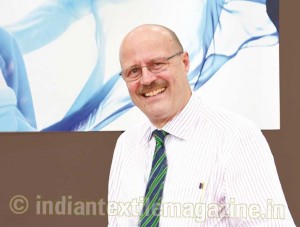By Peter Stahlecker, Joint Managing Director, Spindelfabrik SUESSEN GmbH
The year 2013 is almost over, so this is an opportunity to take stock of what happened during the year and what is in store for us in 2014 and beyond.
As Mark Twain said, predicting the past is easy, predicting the future is impossible. So let us start with the year 2013.
In my view, the most important issue in 2013 has been the tremendous change in the exchange rate INR/EURO. This had already  started in 2012, but surely gained momentum in 2013. From about 72 INR/EURO in early January 2013, it peaked to 92 by the end of August and seems to have settled around 84-85 by now. But keep in mind Mark Twain! It is up to the learned economists to make expert, and often wrong, guesses about where the exchange rate will go in future. It is not the business of this mechanical engineer.
started in 2012, but surely gained momentum in 2013. From about 72 INR/EURO in early January 2013, it peaked to 92 by the end of August and seems to have settled around 84-85 by now. But keep in mind Mark Twain! It is up to the learned economists to make expert, and often wrong, guesses about where the exchange rate will go in future. It is not the business of this mechanical engineer.
This surge made all imported products more costly, but at the same time enhanced India’s position as an exporter. This second effect in my opinion is much more important, that the first.
A second issue was the sudden demand for yarn from China. Nearly every customer I talked to in 2013 – and I had the opportunity to talk to many – was exporting yarn to China. I do not fully understand the reasons for this surge in demand. The positive, and lasting effect is that Chinese customers learned about our Indian spinners’ high quality, their reliability and about their professionalism in doing business. Our spinners in turn learned about the Chinese market.
In some parts of the country, electric power, or rather the unavailability of it, continued to be an issue. It is very remarkable to me how my customers who are affected by this skillfully adapted themselves and continue to make profits.
Another issue was labor, the rising cost and its unavailability. Allow me a comment on this, please. We all want India to develop further, but what does this mean? In my opinion further development exactly means that the most disadvantaged members of society will be better of, and this means higher wages for them. Sweden may have fewer billionaires than India and has not attempted to send a probe to Mars, but we all agree that Sweden is more developed than India.
So, in a way I see this upward trend in wages as a very positive sign of development of our Indian society. A Chinese customer once told me over dinner: “You (he meant Westerners) have no right that some Chinese lady is paid $2 a day for making T-shirts, so you can buy them cheaply”. Right he was.
I think that the year 2013 has been quite good for our industry.
Now we come to the difficult part, saying something about the future. My customers seem to look at the future with fullest confidence. New investments are coming at a rate that I do not recall in my 20 years of being somewhat familiar with the Indian market. I personally share this optimism. As I said before, wages, and cost in general, will go up, but my customers react. They install labor saving equipment which has the positive side-effect of creating more skilled jobs, and they install energy saving equipment. They further increase the efficiency of their operations.
As we all know, over the past 30 years or so, the textile industry has moved from Europe and the US to the East and South-East Asia. We will not grow in the near future, so the demand for textiles will remain. The question is: Will it migrate to some other area, out of India? Africa and Latin America come to my mind, but I do not believe this will happen, at least not so soon.
Both areas have been stagnant or even going backward in the past many years, and I do not see any reason for a reversal of this trend.
So, my view, obviously shared by my customers, is that the outlook for the Indian textile industry is positive. India will develop further and will still remain the center of the textile industry. The power problem will be overcome in due course, making our spinning industry even more competitive. Post spinning will be added, increasing the demand for excellent yarn – and excellent yarn my customers know how to make.
I am personally looking forward to many more years with “my” Indian spinning industry.